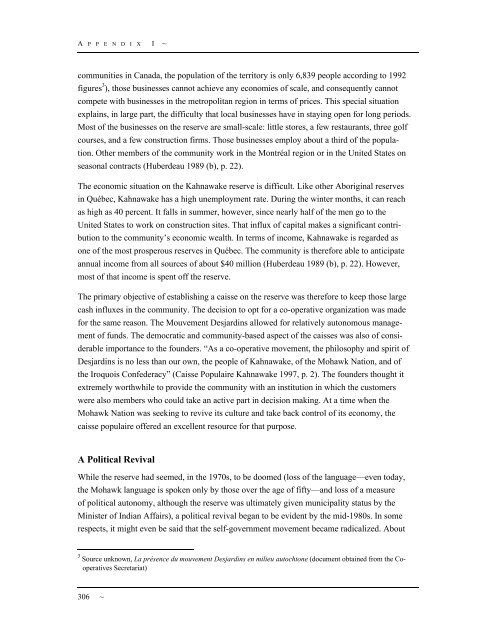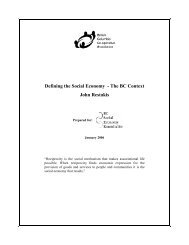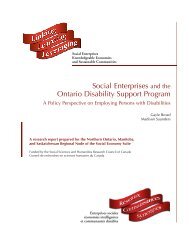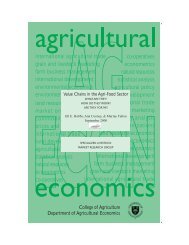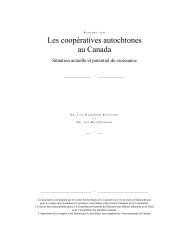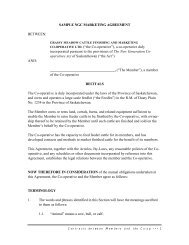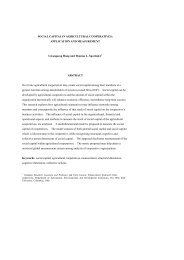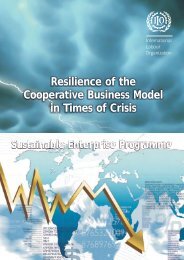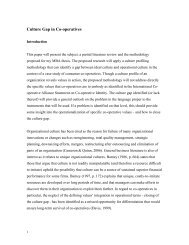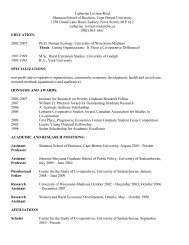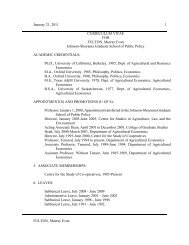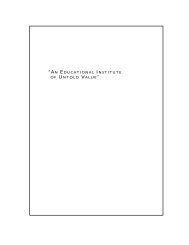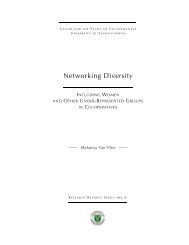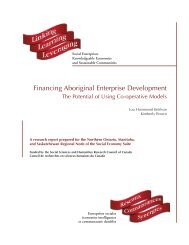Aboriginal Co-operatives in Canada - Centre for the Study of Co ...
Aboriginal Co-operatives in Canada - Centre for the Study of Co ...
Aboriginal Co-operatives in Canada - Centre for the Study of Co ...
You also want an ePaper? Increase the reach of your titles
YUMPU automatically turns print PDFs into web optimized ePapers that Google loves.
A P P E N D I X I ~communities <strong>in</strong> <strong>Canada</strong>, <strong>the</strong> population <strong>of</strong> <strong>the</strong> territory is only 6,839 people accord<strong>in</strong>g to 1992figures 3 ), those bus<strong>in</strong>esses cannot achieve any economies <strong>of</strong> scale, and consequently cannotcompete with bus<strong>in</strong>esses <strong>in</strong> <strong>the</strong> metropolitan region <strong>in</strong> terms <strong>of</strong> prices. This special situationexpla<strong>in</strong>s, <strong>in</strong> large part, <strong>the</strong> difficulty that local bus<strong>in</strong>esses have <strong>in</strong> stay<strong>in</strong>g open <strong>for</strong> long periods.Most <strong>of</strong> <strong>the</strong> bus<strong>in</strong>esses on <strong>the</strong> reserve are small-scale: little stores, a few restaurants, three golfcourses, and a few construction firms. Those bus<strong>in</strong>esses employ about a third <strong>of</strong> <strong>the</strong> population.O<strong>the</strong>r members <strong>of</strong> <strong>the</strong> community work <strong>in</strong> <strong>the</strong> Montréal region or <strong>in</strong> <strong>the</strong> United States onseasonal contracts (Huberdeau 1989 (b), p. 22).The economic situation on <strong>the</strong> Kahnawake reserve is difficult. Like o<strong>the</strong>r <strong>Aborig<strong>in</strong>al</strong> reserves<strong>in</strong> Québec, Kahnawake has a high unemployment rate. Dur<strong>in</strong>g <strong>the</strong> w<strong>in</strong>ter months, it can reachas high as 40 percent. It falls <strong>in</strong> summer, however, s<strong>in</strong>ce nearly half <strong>of</strong> <strong>the</strong> men go to <strong>the</strong>United States to work on construction sites. That <strong>in</strong>flux <strong>of</strong> capital makes a significant contributionto <strong>the</strong> community’s economic wealth. In terms <strong>of</strong> <strong>in</strong>come, Kahnawake is regarded asone <strong>of</strong> <strong>the</strong> most prosperous reserves <strong>in</strong> Québec. The community is <strong>the</strong>re<strong>for</strong>e able to anticipateannual <strong>in</strong>come from all sources <strong>of</strong> about $40 million (Huberdeau 1989 (b), p. 22). However,most <strong>of</strong> that <strong>in</strong>come is spent <strong>of</strong>f <strong>the</strong> reserve.The primary objective <strong>of</strong> establish<strong>in</strong>g a caisse on <strong>the</strong> reserve was <strong>the</strong>re<strong>for</strong>e to keep those largecash <strong>in</strong>fluxes <strong>in</strong> <strong>the</strong> community. The decision to opt <strong>for</strong> a co-operative organization was made<strong>for</strong> <strong>the</strong> same reason. The Mouvement Desjard<strong>in</strong>s allowed <strong>for</strong> relatively autonomous management<strong>of</strong> funds. The democratic and community-based aspect <strong>of</strong> <strong>the</strong> caisses was also <strong>of</strong> considerableimportance to <strong>the</strong> founders. “As a co-operative movement, <strong>the</strong> philosophy and spirit <strong>of</strong>Desjard<strong>in</strong>s is no less than our own, <strong>the</strong> people <strong>of</strong> Kahnawake, <strong>of</strong> <strong>the</strong> Mohawk Nation, and <strong>of</strong><strong>the</strong> Iroquois <strong>Co</strong>nfederacy” (Caisse Populaire Kahnawake 1997, p. 2). The founders thought itextremely worthwhile to provide <strong>the</strong> community with an <strong>in</strong>stitution <strong>in</strong> which <strong>the</strong> customerswere also members who could take an active part <strong>in</strong> decision mak<strong>in</strong>g. At a time when <strong>the</strong>Mohawk Nation was seek<strong>in</strong>g to revive its culture and take back control <strong>of</strong> its economy, <strong>the</strong>caisse populaire <strong>of</strong>fered an excellent resource <strong>for</strong> that purpose.A Political RevivalWhile <strong>the</strong> reserve had seemed, <strong>in</strong> <strong>the</strong> 1970s, to be doomed (loss <strong>of</strong> <strong>the</strong> language—even today,<strong>the</strong> Mohawk language is spoken only by those over <strong>the</strong> age <strong>of</strong> fifty—and loss <strong>of</strong> a measure<strong>of</strong> political autonomy, although <strong>the</strong> reserve was ultimately given municipality status by <strong>the</strong>M<strong>in</strong>ister <strong>of</strong> Indian Affairs), a political revival began to be evident by <strong>the</strong> mid-1980s. In somerespects, it might even be said that <strong>the</strong> self-government movement became radicalized. About3 Source unknown, La présence du mouvement Desjard<strong>in</strong>s en milieu autochtone (document obta<strong>in</strong>ed from <strong>the</strong> <strong>Co</strong><strong>operatives</strong>Secretariat)306 ~


